
Browse an alphabetical list of photographs. These historical images portray people, places, and events before, during, and after World War II and the Holocaust.
<< Previous | Displaying results 2401-2450 of 2641 for "Photo" | Next >>
Tom (left) and Wolf Stein (right), dressed in Turkish-style costumes, attend a party celebrating the Jewish holiday of Purim. Hamburg, Germany, 1936.
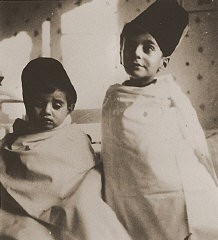
Adolf Hitler, Wilhelm Frick, and Hermann Göring wave to a torchlight parade in honor of Hitler's appointment as chancellor. Behind Göring stands Rudolf Hess. Berlin, Germany, January 30, 1933.

From a window in the Reich Chancellery, German president Paul von Hindenburg watches a Nazi torchlight parade in honor of Adolf Hitler's appointment as German Chancellor. Berlin, Germany, January 30, 1933.
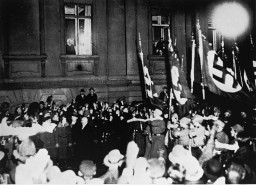
Japanese Americans hold a town hall meeting at the Manzanar Relocation Center in California, 1943.
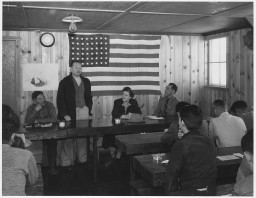
Train station in the Westerbork camp. Westerbork, the Netherlands, between 1942 and 1944. From 1942 to 1944 Westerbork served as a transit camp for Dutch Jews before they were deported to killing centers in German-occupied Poland.
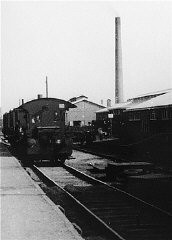
Train station near the Treblinka killing center. This photo was found in an album belonging to camp commandant Kurt Franz. Poland, 1942-1943.
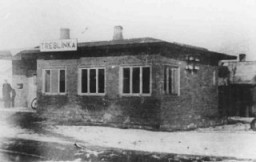
Drafting class sponsored by ORT (Organization for Rehabilitation through Training). Zeilsheim displaced persons camp. Germany, postwar.
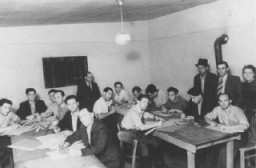
Training for emigration to Palestine: a math class at the Caputh Agricultural School. Berlin, Germany, 1930–39.
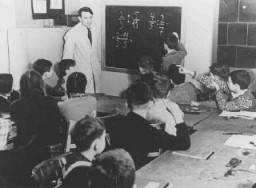
Jewish youth attend a class on transplanting seedlings, part of a general course in farming sponsored by the American Jewish Joint Distribution Committee at the Bergen-Belsen displaced persons camp. Germany, August 1, 1946.
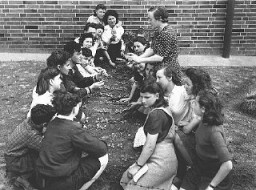
Translators operate an IBM machine during a session of the International Military Tribunal. (Source record ID: A65III/RA-198-D)
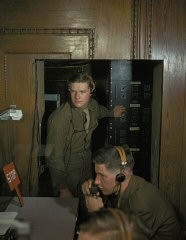
English, French, Russian, and German were official languages of the Nuremberg trials. Translators provided simultaneous translations of the proceedings. Here, they route translations through a switchboard to participants in the trial. Nuremberg, Germany, November 1945.
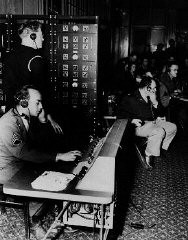
Trench warfare is one of the iconic symbols of World War I. This photograph shows British troops carrying boards over a support line trench at night during fighting on the western front. Cambrai, France, January 12, 1917.
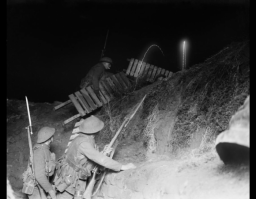
Participants in the July 1944 plot to assassinate Adolf Hitler and members of the "Kreisau Circle" resistance group on trial before the People's Court. Pictured are Dr. Franz Reisert, Dr. Theodor Haubach, Graf von Moltke, Theodor Steltzer, and Dr. Eugen Gerstenmeier.
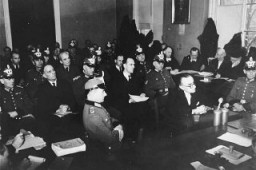
Chief defense attorney Mark O'Conner (standing) addresses a question to John Demjanjuk during Demjanjuk's trial. Jerusalem, Israel, Feburary 16, 1987.

The courtroom where Klaus Barbie, former Gestapo (German Secret State Police) chief in Lyon, was tried on charges of crimes against humanity. Lyon, France, May 1987.
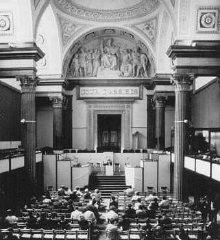
Participants in the July 1944 plot to assassinate Hitler on trial before the People's Court of Berlin. Berlin, Germany, August–September 1944.
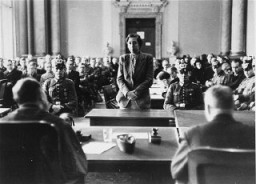
Ben Meed, President, American Gathering of Jewish Holocaust Survivors, standing in front of flags of the liberating divisions. This photograph was taken as he spoke at a ceremony held during the United States Holocaust Memorial Museum's Tribute to Holocaust Survivors: Reunion of a Special Family. This was one of the Museum's tenth anniversary events. Washington, DC, November 2003.
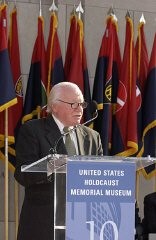
View of a ceremony held during the Museum's Tribute to Holocaust Survivors: Reunion of a Special Family, one of the United States Holocaust Museum's tenth anniversary events. Flags of the liberating divisions form the backdrop to the ceremony. Washington, DC, November 2003.

Benjamin Meed, Elie Wiesel (second and third from left), and two children bury a time capsule during the Tribute to Holocaust Survivors: Reunion of a Special Family, one of the Museum's tenth anniversary events. Washington, DC, November 2003.
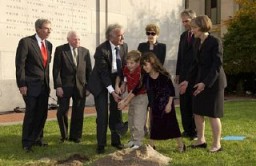
Assault troops in a landing craft approach Omaha Beach on D-Day. Normandy, France, June 6, 1944.
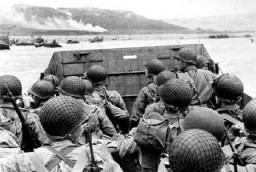
Destroyers of the Royal Navy carry British troops evacuated from Dunkirk. Dover, England, May 31, 1940. IWM (H 1640)
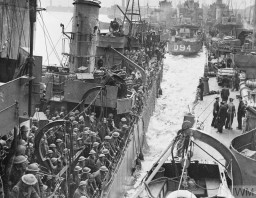
German police and SS personnel wait with a convoy of trucks during a shooting action in the Palmiry forest near Warsaw. These trucks were used to transport prisoners held in the Pawiak and Mokotow prisons. October–December 1939.
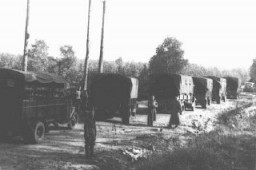
Soon after liberation, a British woman helps a camp survivor try on shoes. Bergen-Belsen, Germany, after May 1945.
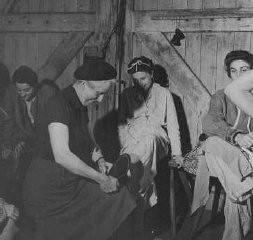
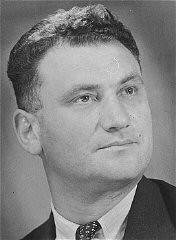
Dated June 6, 1944, this US Twelfth Army Group situation map shows the presumed locations of Allied and Axis forces on D-Day, when Allied troops landed on the beaches of Normandy. Drafted during the war, the content in this historical map reflects the information that operational commander, General Omar N. Bradley, would have had on hand at the time.

Studio portrait of two Armenian girls wearing traditional clothing. Ottoman Empire, ca 1895. [Courtesy of Mabel Aharonian]
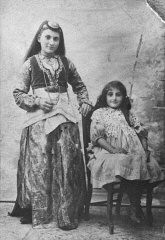
Two Austrian refugee children, part of a group of predominantly Jewish refugee children on a Children's Transport (Kindertransport), upon their arrival in Great Britain. Harwich, Great Britain, December 12, 1938.
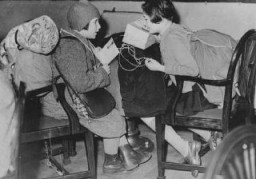
Two young cousins shortly before they were smuggled out of the Kovno ghetto. A Lithuanian family hid the children and both girls survived the war. Kovno, Lithuania, August 1943.

Two French partisans, Missak Manouchian (left) and Wolf Wajsbrot (right), who belonged to the French armed resistance group Francs-Tireurs et Partisans. They were executed by firing squad on February 21, 1944. Paris, France, February, 1944.

Two German Jewish families at a gathering before the Nazi rise to power. Only two people in this group survived the Holocaust. Germany, 1928.
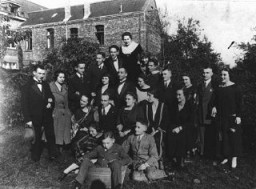
Portrait of two Jewish girls dressed in traditional Macedonian costume in a private home in Bitola. Pictured are Matilda Kamchi (or Camhi, left) and a friend. Both perished in Treblinka. Bitola, 1937.
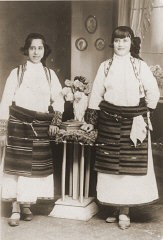
Two Jewish men, wearing badges identifying them as Jews, stand before SS men in the Ponary forest outside Vilna. Ponary served as the main Nazi killing site for Vilna's Jewish inhabitants. ca. July 1941.
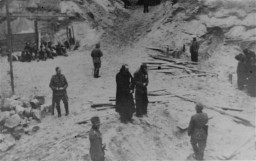
Bedukian Sarkis, a French partisan of Armenian extraction, patrols a street along with another partisan during the August 1944 insurrection in the south of France. Marseille, France, August 1944.
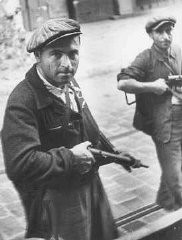
Two malnourished Soviet prisoners of war, survivors of the Hemer prisoner of war camp in western Germany. More than three million Soviet prisoners of war died in German custody, mostly from malnutrition and exposure. Hemer, Germany, April 29, 1945.
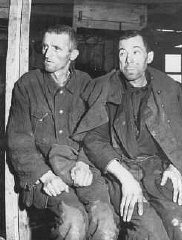
Portrait of two men standing in a doorway in the former Budapest ghetto, one of whom is wearing a painted yellow star on his jacket. Photograph taken by Yevgeny Khaldei. Budapest, Hungary, 1945.
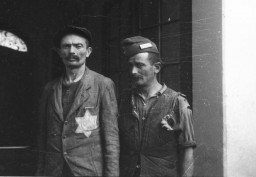
Photograph of two of the Tehran Children, who reached Palestine in 1943 via Iran.

Two ovens inside the crematorium at the Dachau concentration camp. Dachau, Germany, July 1, 1945. This image is among the commonly reproduced and distributed images of liberation. These photographs provided powerful documentation of the crimes of the Nazi era.
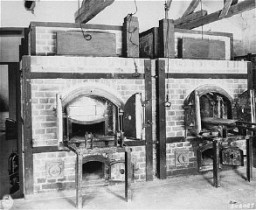
Two political prisoners, after US soldiers liberated the Gusen concentration camp. Austria, May 12, 1945.
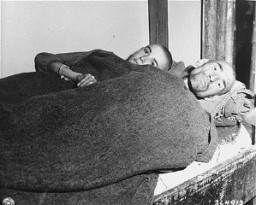
Close-up portrait of two prisoners in the Im Fout labor camp in Morocco. The camp was approximately 59 miles southwest of Casablanca, and housed a group of foreign workers. Many of the prisoners fell ill because of poor living conditions in the camp. Im Fout, Morocco, 1941-42.
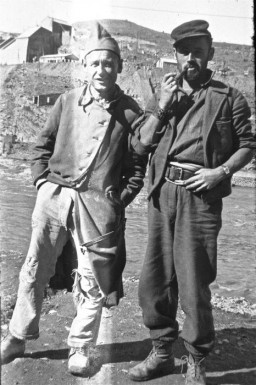
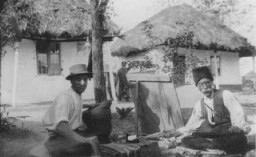
Two survivors in front of the women's barracks in the Bergen-Belsen concentration camp. Bergen-Belsen, Germany, April 1945. © IWM (BU 3740)
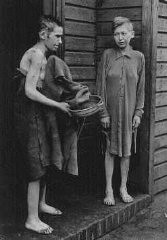
Two survivors prepare food outside the barracks in Dachau, Germany, May 1945. This image is among the commonly reproduced and distributed images of liberation. These photographs provided powerful documentation of the crimes of the Nazi era.
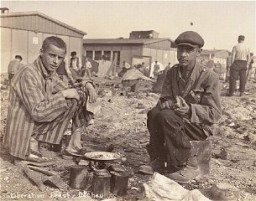
Two American soldiers cross the Rhine River into Germany on March 29, 1945. In the foreground is Jack Caminer, who emigrated from Germany to the United States in 1938. After he was drafted into the US Army, Caminer was sent to Camp Ritchie to prepare for intelligence work. Caminer participated in the liberation of Ohrdruf.
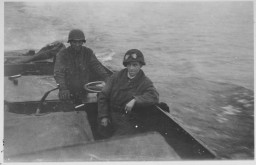
A young boy holding his younger brother in the Kovno ghetto. Older children frequently cared for younger siblings in the ghetto. Photographed by George Kadish. Kovno, Lithuania, 1941.
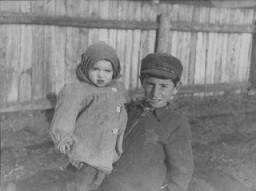
Two young brothers, seated for a family photograph in the Kovno ghetto. One month later, they were deported to the Majdanek camp. Kovno, Lithuania, February 1944. Pictured are Avram (5 years) and Emanuel Rosenthal (2 years). Emanuel was born in the Kovno ghetto. The children, who were deported in the March 1944 "Children's Action," did not survive. Their uncle, Shraga Wainer, who had asked George Kadish to take this photograph, received a copy of it from the photographer after the war in the Landsberg…
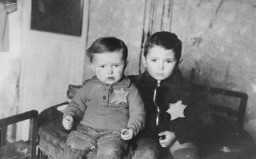
An underground bunker, built by Jews in Warsaw in preparation for anti-Nazi resistance. This photograph shows cooking facilities in a bunker. Jews hid in bunkers while the Germans systematically destroyed the ghetto during the uprising. Warsaw, Poland, April 19–May 16, 1943.
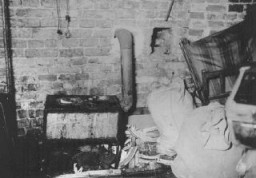
Soviet officers preside over the opening and exhumation of a mass grave at the Ninth Fort. Photographed by George Kadish. Kovno, Lithuania, 1944.
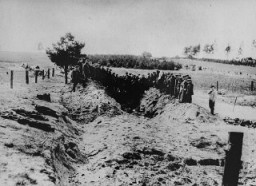
A unit of Soviet soldiers walks along a narrow strip of land that juts into the water while on a reconnaissance mission in Murmansk. Photograph taken by Soviet photographer Yevgeny Khaldei. Murmansk, Soviet Union, 1941.
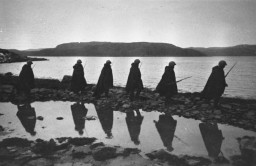
William Proxmire (1915–2005) served in the United States Senate for the state of Wisconsin from 1957 to 1989. Senator Proxmire was one of the strongest advocates for the UN Convention on the Prevention and Punishment of Genocide, which was ratified by the United States in 1988.
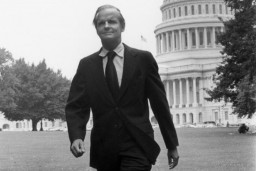
A welfare officer of the United Nations Relief and Rehabilitation Administration (UNRRA) assists Polish Jewish orphans en route to France and Belgium. Prague, Czechoslovakia, probably 1946.
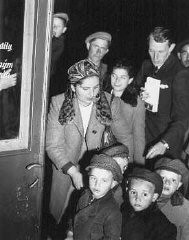
We would like to thank Crown Family Philanthropies, Abe and Ida Cooper Foundation, the Claims Conference, EVZ, and BMF for supporting the ongoing work to create content and resources for the Holocaust Encyclopedia. View the list of donor acknowledgement.